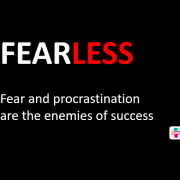If I ask you, ‘What is causing you to procrastinate?’ what would your answer be?
Too much to do and don’t know where to start?
I don’t want to do it so I’m delaying the inevitable pain of getting it done?
Well, these are pretty rational causes for procrastination and, having a clear plan, diarising actions, using the five-minute rule (agree to do just 5 minutes and you’re away) or, getting the hardest thing done first are all likely to increase your productivity in no time!
Frequently though procrastination is a lot less rational and when we dig deeper, what drives a great number of us to procrastinate is fear.
Ask yourself, ‘Why am I procrastinating?’ and again, ‘Why?’ to help dig down to the root cause of your procrastination. What is the true driver or trigger stopping you from taking action?
Often, the real reason we are not doing what we’ve set out to achieve is fear.
FEAR OF FAILURE
FEAR OF JUDGEMENT
FEAR OF BEING DIFFERENT
And even, FEAR OF SUCCESS
If you think about it, fear is basically what stops us taking action. Sometimes it’s rational but most of the time, it is not.
Did you know that there are only two instinctive fears at birth? Fear of falling and fear of loud noises.
All other fears are acquired and learned over our lifetime. So what is learned can also be unlearned, particularly if it’s not resourceful to us, it’s stopping us getting to where we want to be, doing what we want to do and, feeling what we want to feel.
Action cures fear.
Indecision, postponement, on the other hand, fuel fear.
David J Schwartz
So how do we move beyond our fears, reduce procrastination and, take action?
Firstly, awareness is key. Just by reading this post, reflecting on why you procrastinate and considering your triggers, you will have gained a deeper insight into your ‘self’. Awareness and self-knowledge are key in helping us get un-stuck.
Put fears into perspective. Get rid of catastrophizing. What are the facts? Try asking yourself this powerful and resourceful question:
What am I assuming that is stopping me taking action?
What is true?
If I know this is true what action will I take?
Uncovering new empowering beliefs can help us manage and even overcome our fears.
Another great way to help you reduce fear and anxiety is to try some mind training such as meditation or simple breathing exercises. The 4-7-8 X 7 breathing exercise is simple and effective: Breathe in through your nose while counting to four, hold your breath and count to seven, and then exhale through your mouth while counting to eight. Repeat this pattern seven times. Deep breathing techniques* help stimulate relaxation. As you take in more oxygen, your heart rate slows and your mind starts to slow down, relaxing you and your brain and, giving you time to think and be at your best.
Fears are nothing more than a state of mind.
Napoleon Hill
Our brain plays a very big role when it comes to fear and while it can seem complex (and I am no neuroscientist) there are some great resources out there to help us better understand how our brain works and how fear is triggered. I particularly like ‘The Chimp Paradox’ by Dr. Steve Peters, not just because it talks about bananas, chimps and, planets but because it does simplify the concept of how the mind works, how it impacts our emotions, how to manage our self better and ignite our human potential.
As a coach, I can help you reduce fear and procrastination by helping you raise your ‘self’ awareness, uncovering your limiting assumptions and, helping you replace these with empowering, resourceful truths that support you to be at your best to take positive action.
As an NLP (Neuro Linguistic Programming) Practitioner, I can work with you to have and immediate and lasting impact on fear, including phobias. To learn more about NLP or coaching please do get in touch as I’d be delighted to speak with you!
Caroline @4PositiveGrowth
*While inhaling and exhaling sounds pretty self-explanatory, most of us don’t naturally take deep belly breaths. Instead, we tend to take shallow breaths that don’t allow our lungs to fill with air or our bellies to rise and fall. To practice deep breathing techniques, sit in a quiet and comfortable seat. Take a slow deep breath in through your nose. Let your rib cage expand and belly rise as your lungs fill with air. Exhale slowly, and feel your belly and chest fall. You can place one hand on your belly and one hand on your chest to feel the accordion-like movement of your torso. Keep taking full, deep breaths until you start to feel a sense of calm.

